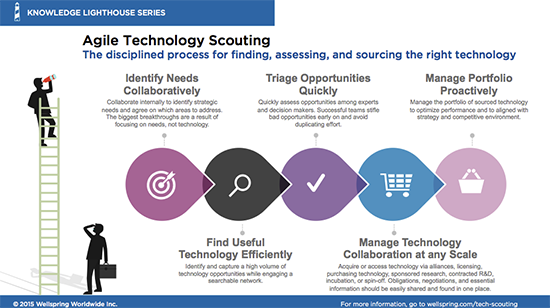Innovation is rarely the result of a single eureka moment. In fact, the vast majority of disruptive technologies enter the market after being adapted from another industry, discipline, or use. The commingling of ideas, and the rate at which companies can adopt external sources of information, has been proven to increase innovation on an ongoing basis.
It is no surprise, then, that open innovation, industry-university research partnerships, and, in particular, external technology scouting have been increasing in both frequency and overall productivity for the better part of twenty years. The application of outside technologies is incredibly important, and for any organization to achieve repeated and sustainable innovation, these techniques need to be embraced as critical business activities and reinforced with a systematic process.
In this series, we will introduce the concept of Agile Technology Scouting and demonstrate that, with some simple changes to their current practices, organizations can drastically increase the effectiveness of external scouting activities—and greatly improve their overall performance in the process.
To begin, though, we must first define Agile Technology Scouting - a model for technology acquisition.
Wellspring has helped clients and heard from experts in the field on how to optimize their open innovation and scouting processes, and in doing so we have been exposed to the practices of firms large and small, in every industry imaginable. It is through these interactions that we have determined the best process for collaborative, efficient, and successful technology scouting. The stages of the Agile Scouting Process are:
- Identify Needs Collaboratively
In the initial stage it is important for organizations to collaborate internally to identify strategic needs and agree on areas to address. The biggest breakthroughs an organization can produce are often the result of focusing on internal needs, not technology. A central enterprise repository and collaboration area for created projects can organize your team initiatives around strategic needs. If done right, you minimize conflicting and redundant efforts.
2. Find Useful Technology Efficiently
After the internal needs have been addressed, it is important to identify and efficiently capture a high volume of technology opportunities while engaging a searchable network. To achieve this, scouts must leverage many different sources, including online marketplaces of available technologies.
This strategy prevents the loss of opportunities without creating cumbersome data entry. Opportunity capture should be seamless, so scouts don’t let potential deals slip through the administration process cracks.
Additionally as scouts add the new technologies, a central system for all the related organizations and contacts makes it easy to find critical connections without wasting time.
- Triage Opportunities Quickly
Quickly assessing opportunities improves overall efficiency and effectiveness. Experts and decision makers need access to technology evaluations in order to kill bad opportunities quickly and avoid duplicated effort. Just think, if you have 100 technologies, you may only act on a handful due to fit and resources.
Agile teams have scorecards that provide a framework for consistent assessments. They score each opportunity and make their assessments available to everyone necessary to make informed decisions. Ideally, assessment requests are routed to all the essential players, which enables collaboration and shared insights.
Many teams also have regular meetings to review their pipelines. An agile scouting team has a pipeline report ready and up-to-date. With all the information at hand, effective organizations winnow the deals they want to focus on early in the process to maximize the team’s impact.
- Manage Technology Collaboration at any Scale
In this stage, scouts need to acquire or access technology via alliances, licensing, purchasing technology, sponsored research, contracted R&D, incubation, or spin-off. As a best practice, all obligations, negotiations, and essential information should be stored in one central location for easy search-ability and sharing.
By proactively managing contracts, agile scouts can quickly find financial and non-financial obligations and clearly communicate this information to others who must comply or be aware of these obligations. Plus, they have other key pieces of information easily accessible to best handle negotiations. With this approach, they can eliminate unnecessary surprises or costs.
- Manage Portfolios Proactively
At this point the technology becomes part of the company’s overall knowledge base and needs to be treated as a new component of the “knowledge supply chain.” Innovation professionals need to manage the portfolio of sourced technology to optimize performance and ensure that strategic alignments move forward.
Agile teams track portfolio performance and KPIs with reporting tools such as automated scheduled reports. These automated reports keep the portfolio front and center for regular review. We have seen teams either e-mail their reports or have them on their dashboards.
Further Discussion
Over the next few months we will be examining the Agile Technology Scouting concept in greater detail and breaking down each aspect of the scouting process to provide more specific best practices and actionable advice. Future topics will include: Identifying Opportunities, Speed to Decision, Negotiations Power, Portfolio Value Optimization, and Efficient Resource Allocation.


